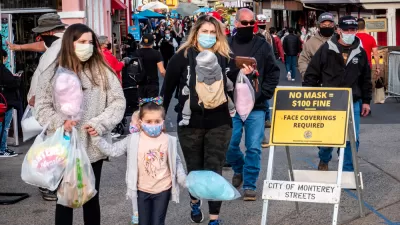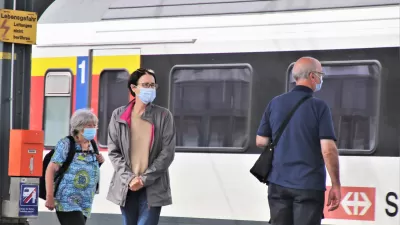Do you know the COVID risk level where you live, work and play? Many COVID data trackers provide county and state-level data, but metropolitan area data had been more difficult to find until now, thanks to Covid Act Now.

Covid Act Now, a small, independent 501(c)(3) nonprofit that works with Georgetown University Center for Global Health Science and Security, Stanford University Clinical Excellence Research Center, and the Harvard Global Health Institute, is one of the most useful websites for tracking the coronavirus in the United States (50 states + D.C, Puerto Rico, and the Northern Mariana Islands). Last month it expanded beyond state and county-level data to provide metropolitan area COVID data based on four key health metrics:
- Daily new cases or case incidence
- Infection rate, a measurement of the reproduction of the virus, or Rt
- Test positivity rate
- Intensive Care Unit (ICU) capacity
"We heard your feedback and recognize that COVID spread does not end at the county line," states the Jan. 12 edition of their newsletter entitled, "New tools to track and understand COVID."
With our new metros feature, you can now explore aggregated COVID risk for 384 metro areas across the U.S.
The website is helpful even for non-COVID purposes as it provides the geographic definitions (by counties) and population data for 392 metros. The homepage shows the eight most populous metros, from the "New York City metro, NY-NJ-PA," pop. 19,200,000, to the "Atlanta metro, GA," pop. 6,020,000. Below #8 (all entries are numbered, a useful tool not found in all trackers) you can click on, "View top 100 metro areas." #100 is Spokane is the "Spokane metro area, Wash.," pop. 569,000, consisting of two counties.
The New York Times has a very useful Metro Area coronavirus tracker that is not interactive like the paper's main tracker and is confined to 20 entries showing the highest scorers in only one metric, case incidence. While less detailed, it's simplicity is to be appreciated, providing the user with case data that answers three questions:
- "Where the Outbreak Is Worst Now" (daily case incidence in the last 2 weeks, which is what Covid Act Now does in much more detail)
-
"Where There May Be Bad News Ahead: ...where new reported cases are rising the fastest, on a population-adjusted basis" (similar to the infection rate, or Rt, metric used by Covid Act Now)
-
"The Places Hit Hardest: the metro areas that have had the highest cumulative case rates [per 1,000 people] since the start of the outbreak". Here's where the Times beats Covid Act Now which doesn't provide cumulative data.
The Covid Act Now newsletter continues:
Since metro areas share key resources, such as hospitals, schools, and grocery stores, metro data will help give you a more contextualized understanding of COVID risk and ICU capacity. Read more about the importance of metro level data in our deep dive.
From their Dec. 22, 2020 blog (deep dive), the source article for this post, which introduced the new feature:
Metros, or Metropolitan Statistical Areas (MSAs), are census-defined regions that consist of a city with 50,000 or more inhabitants and its surrounding communities...Because MSAs are defined by the everyday movement of people, rather than by geographic boundaries, they measure the way COVID spreads through communities better than data at the county or state level.
Using the tracker
So, which large (500,000+ pop.) metros are the hardest hit? As of Jan. 17, California dominates daily new cases, with Riverside metro, Oxnard metro (Ventura County), and Los Angeles metro showing daily new cases ranging from 145 per 100,000 people to 133 per 100,000 people, respectively.
However, when looking at the infection or reproduction rate, Texas dominates, with the San Antonio metro showing a 1.24 infection rate (every infected person can be expected to spread the virus to 1.24 people). By contrast, the aforementioned California metros show a range from 0.99 to 1.1.
Improvement in California
The Los Angeles Times reports on Jan. 16 that "there are some signs that the daily increase in the number of coronavirus cases is beginning to flatten in California."
Gov. Gavin Newsom described the flattening numbers as “light at the end of the tunnel,” adding that the coronavirus test positivity rate and the number of people in hospitals and intensive care units with COVID-19 have been declining.
Two of those three metrics are available on Covid Active Now and can be viewed by county or metro region. As for the non-ICU hospitalizations, The Washington Post tracker has that metric for a state-level comparison.
Related in Planetizen:
- The Pandemic's Most Critical Health Metric Just Shut Down Most of California, December 7, 2020
- Corona Crisis in America: The Metropolitan Area to Watch, November 3, 2020
-
Do You Know Your COVID-19 Colors? July 29, 2020
FULL STORY: Covid Act Now Launches Metro Data

Planetizen Federal Action Tracker
A weekly monitor of how Trump’s orders and actions are impacting planners and planning in America.

San Francisco's School District Spent $105M To Build Affordable Housing for Teachers — And That's Just the Beginning
SFUSD joins a growing list of school districts using their land holdings to address housing affordability challenges faced by their own employees.

The Tiny, Adorable $7,000 Car Turning Japan Onto EVs
The single seat Mibot charges from a regular plug as quickly as an iPad, and is about half the price of an average EV.

Seattle's Plan for Adopting Driverless Cars
Equity, safety, accessibility and affordability are front of mind as the city prepares for robotaxis and other autonomous vehicles.

As Trump Phases Out FEMA, Is It Time to Flee the Floodplains?
With less federal funding available for disaster relief efforts, the need to relocate at-risk communities is more urgent than ever.

With Protected Lanes, 460% More People Commute by Bike
For those needing more ammo, more data proving what we already knew is here.
Urban Design for Planners 1: Software Tools
This six-course series explores essential urban design concepts using open source software and equips planners with the tools they need to participate fully in the urban design process.
Planning for Universal Design
Learn the tools for implementing Universal Design in planning regulations.
Smith Gee Studio
City of Charlotte
City of Camden Redevelopment Agency
City of Astoria
Transportation Research & Education Center (TREC) at Portland State University
US High Speed Rail Association
City of Camden Redevelopment Agency
Municipality of Princeton (NJ)





























